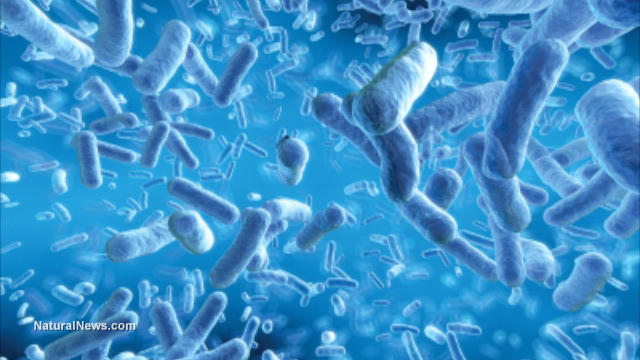Scientists stunned as common bacteria quickly transform into drug-resistant superbugs
Thursday, September 15, 2016 by: J. D. Heyes
Tags: bacteria, superbugs, antibiotic resistance

(NaturalNews) For years we have been warning of an impending medical catastrophe due to the over-prescribing and overuse of antibiotics. In fact, as we reported last year, hospitals are some of the most prolific breeding grounds for drug-resistant superbugs, killing more patients a year than measles.
Now, scientists have captured the horror of superbug creation on video, which you can watch here, compliments of NPR. Researchers from Harvard Medical School filmed a horrifying experiment in which they created a bacteria that is 1,000 times more drug-resistant than their ancestors. The time-lapse video shows a white bacterial colony spreading across a large black petri dish with vertical bands of progressively higher doses of antibiotics.
As you watch, you'll see that the colony pauses its expansion after reaching the first band of antibiotics, forming a distinct border between the white spreading colony and the black petri dish. However, the bacteria then begin edging into the toxic mass, and more dots appear and begin growing. They then sprint towards the next band of antibiotics. At the same time, the bacteria are evolving into a different strain, able to withstand more and higher doses of antibiotics. After two weeks, they have become resistant to the strongest antibiotic employed and have taken over the plate-sized black petri dish. Along the way, each evolving strain survives by taking over and absorbing competing mutant strains.
Scary stuff, indeed.
New technique shows how stronger strains crowd out weaker, more drug-resistant strains
Scientists are aware that bacteria are getting stronger and stronger with each passing year. They also note that is in large part the fault of both the medical community and uniformed patients who tend to insist upon being prescribed "something" for their illness. That usually takes the form of an antibiotic, even for viral infections (antibiotics have no effect on viruses). And far too many health care providers willingly oblige. The end result is getting more dangerous all the time: As NPR reported, 23,000 people die in the U.S. alone each year as a result of infections by superbugs. However, it isn't typical to see a superbug actually develop.Tami Lieberman, an evolutionary microbiologist at MIT, says that to most, evolution is just a conceptual construct. She and her Ph.D. advisor, Roy Kishony, of Harvard Medical School, hoped to build a model that would depict a more concrete example of how superbugs evolve. "The goal was to see evolution, not to abstract it," she told NPR.
The video, along with their report and observations, were published recently in the journal Science.
In having the E. coli bacteria grow across progressively higher antibiotic doses, the researchers were able to create images of an evolving bacterial as it spread across the petri dish. However, the concept had another effect that the scientists had not anticipated. As faster growing colonies of resistant bacteria were growing, they cut off the growth of slower colonies that are more drug resistant. That effect compounded the success of the faster-growing, more resistant colonies.
Experiment makes it easier for scientists to study superbug development
Scientists note that as bacteria evolve in terms of drug resistance, that generally comes at some expense to the bug. If antibiotics are present, the faster-growing colonies usually don't grow as much as the slower ones, NPR reported. However, many times that is of no consequence because if a strain wants to survive, it merely needs to be the first to move on to the next human or food source.Michael Baym, the post-doctoral candidate who built the 4 foot-by-two foot petri dish in Kishony's lab, said that the superbug phenomenon "has been very, very tough to study classically." But using his model, it is very easy to demonstrate how a superbug evolves into something more and more difficult to kill.
The idea is, if scientists can actually see the concept, they can begin to make strides in studying the phenomenon. Utilizing something as simple as a massive petri dish might be just what scientists introduce a concept into the lab that has been missing, according to Pamela Yeh, a UCLA microbiologist who did not take part in the experiment. "Hopefully this will put back in people's minds how important the spatial element can be," she said.
"Getting more people to understand how quickly bacteria evolve antibiotic resistance might help people understand why they shouldn't be prescribed antibiotics. The drug resistance is not some abstract threat. It's real," added Lieberman.
Sources:
NaturalNews.com
NPR.org
Science.NaturalNews.com
ScienceMag.org
Bacteria at FETCH.news
Get independent news alerts on natural cures, food lab tests, cannabis medicine, science, robotics, drones, privacy and more.
Take Action: Support Natural News by linking to this article from your website
Permalink to this article:
Embed article link: (copy HTML code below):
Reprinting this article:
Non-commercial use OK, cite NaturalNews.com with clickable link.
Follow Natural News on Facebook, Twitter, Google Plus, and Pinterest
- Newly released JFK files reveal Pentagon's role in creating Lyme disease and covid in the same lab
- Ginseng's hidden anti-aging power: How compound K is rewriting the rules of skincare
- “Endgame: The Hidden Agenda 21” unveils a world of conspiracy and control
- L.A.'s rebuilding nightmare: Only 4 permits issued after fire destroys 6,000 homes
- Scientists demand FDA withdraw mRNA COVID vaccines amid contamination and gene therapy concerns
- Dr. Suzanne Humphries makes bombshell appearance on Joe Rogan podcast, exposing vaccine industry deception back to POLIOMYELITIS
- Former Congresswoman exposes CCP's deep infiltration of California through universities, ports, and fentanyl
- “The shame of Minnesota”: Somali immigrants behind $250 million child nutrition fraud in largest COVID-era scam
- PROCESSED TABLE SALT in foods found to fuel depression
- “Independent” anti-Russia outlet MEDUZA faces COLLAPSE as US funding dries up
- Here are TEN all-natural ways to protect your garden without using harmful chemicals
- BPA: The hidden hormone disruptor sabotaging your health - and how to fight back
- Chewing gum's dirty secret: How your daily habit could be flooding your body with microplastics
- The hidden battle in your glass: How A1 and A2 milk could shape your health
- Discovery of vast underground city beneath Giza pyramids challenges human history
- Black cumin seed oil emerges as a powerful ally against breast cancer and chronic inflammation
- CDC finally halts $11 billion COVID funding scam as health officials admit the ‘pandemic’ was a fraud
- Catastrophic 7.7 earthquake devastates Myanmar and Thailand; death toll could reach 100,000
- Newly released JFK files reveal Pentagon's role in creating Lyme disease and covid in the same lab
- Analysis: The coming economic collapse, a mass uprising and Trump's three secret weapons to halt the growing revolt
- Festive flavors: The sweet history, nutritional profile and health benefits of pecan pie
- Elon Musk: Aliens could be here on Earth RIGHT NOW
- Trump reverses course on Gaza plan, says “nobody is expelling Palestinians”
- Big Pharma's $8 Billion bribery scheme exposed: how doctors are pushed to prescribe junk science, not heal
- Boys are back in town: Trump’s patriotic alpha crew takes the wheel while toxic females ride in the backseat
- Reclaim your health: How midlife exercise reverses years of inactivity
- A lack of integrity in Academia: Harvard professor found GUILTY of fraudulent research to promote CRT theory
- Survival 101: Effective EMF blocking techniques
- EPA advisor admits the agency is funneling billions to climate groups ahead of Trump’s return to White House
- Dr. Mike Yeadon releases 15-minute testimony - WATCH - about genocidal intent of COVID “vaccines”
- 5 Simple steps to boost your brainpower: How to strengthen executive function in a distracted world
- Florida takes a stand: DeSantis proposes permanent ban on mRNA vaccine mandates
- Sugarcane extract superior to cholesterol-lowering drugs?
- Mike Adams Sermon 66: God will DESTROY ISRAEL for its wickedness
- Pilots report mysterious lights 'moving at extreme speeds' across Oregon skies
- Space war brewing? Russia threatens to destroy Starlink satellites
- EPA advisor admits the agency is funneling billions to climate groups ahead of Trump’s return to White House
- California's social media censorship law struck down: A victory for free speech or a threat to online safety?
- The Health Ranger releases “Vaccine Zombie” song and music video, using AI-animated zombies for the music video
- Dr. Mike Yeadon releases 15-minute testimony - WATCH - about genocidal intent of COVID “vaccines”
- The pandemic as a tool for INDOCTRINATION: Understanding “The Indoctrinated Brain” by Dr. Michael Nehls
- Newly released JFK files reveal Pentagon's role in creating Lyme disease and covid in the same lab
- Florida takes a stand: DeSantis proposes permanent ban on mRNA vaccine mandates
- Mike Adams releases country western hit single: Goin’ Back in Time is Comin’ Home
- Mike Adams releases music poetry sensation: A Child of God
- “Why we influenced the 2020 elections”: Facebook files reveal the coordinated effort to bury the Hunter Biden laptop story
- Unpacking the Lies That We’ve Been Fed – new song and music video released by Mike Adams, the Health Ranger
- RFK Jr. clears key hurdle: Sen. Susan Collins backs controversial HHS nominee, signaling a new era for health policy
- Mike Adams releases new song and music video: Nothing More Disgusting Than a Globalist
- Michigan sheriff announces criminal investigation into 2020 election crimes, Dominion Voting Systems
- Israeli soldiers accused of even more torture and abuse in the West Bank
- Migrants are taking advantage of recent hurricanes to scam residents and loot their homes
- House Intelligence Committee calls for the ARREST and PROSECUTION of Dr. Anthony Fauci
- Rep. Nancy Mace introduces bill to ban biological males from female facilities on federal property
- Red Cross issues warning to stop blood plasma donations from vaccinated people
- Scientists confirm: GENIUS brain function can be spontaneously unleashed in humans without any apparent cause
- EPA advisor admits the agency is funneling billions to climate groups ahead of Trump’s return to White House
- HYSSOP: What research reveals about the health benefits of this ancient holy herb
- Two containers with completed ballots fall out of truck in Florida
- Fully vaccinated about to see “tsunami” of illness and death, warns virologist
- Global leaders unite to clamp down on “misinformation” with UN-backed Cascais Declaration
- BREAKING: 2025 NDAA authorizes mandatory military draft of WOMEN across America… as Pentagon pursues global NUCLEAR war with both Russia and China at the same time
- Michael Yon warns of a ZIONIST TAKEOVER in Trump’s second administration
- BOMBSHELL: DNA testing kits are a SCAM to develop ethnic-specific bioweapons
- Ozempic and Wegovy weight loss drugs are injectable LIZARD VENOM PEPTIDES that may unleash a devastating wave of organ failure… side effects align with symptoms of SNAKE BITES
- Israeli soldiers accused of even more torture and abuse in the West Bank
- These 13 countries just signed an agreement to engineer a global FAMINE by destroying food supply
- NASA admits that climate change occurs because of changes in Earth’s solar orbit, and NOT because of SUVs and fossil fuels
- RFK Jr. clears key hurdle: Sen. Susan Collins backs controversial HHS nominee, signaling a new era for health policy
- Sermon 30: How Jesus reveals Caesar’s FAKE CURRENCY and FALSE AUTHORITY
- Coriander seeds: Ancient medicine backed by modern science
- Arizona officials claim Maricopa County needs 10-13 days to tabulate results of the election
Science News & Studies
Medicine News and Information
Food News & Studies
Health News & Studies
Herbs News & Information
Pollution News & Studies
Cancer News & Studies
Climate News & Studies
Survival News & Information
Gear News & Information
News covering technology, stocks, hackers, and more



"Big Tech and mainstream media are constantly trying to silence the independent voices that dare to bring you the truth about toxic food ingredients, dangerous medications and the failed, fraudulent science of the profit-driven medical establishment.
Email is one of the best ways to make sure you stay informed, without the censorship of the tech giants (Google, Apple, Facebook, Twitter, YouTube, etc.). Stay informed and you'll even likely learn information that may help save your own life."
–The Health Ranger, Mike Adams












































